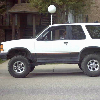Bennett Lewison
Member
- Joined
- May 7, 2003
- Messages
- 11
- Reaction score
- 0
- City, State
- Maple Lake,Minn.
- Year, Model & Trim Level
- 93 XLT
R134a conversion
Hello again, i didn't mean to step on any toes here. When i posted about my own inexpensive conversion from R-12 i was only relating my own personal experience with the kit. It was three years ago when i noticed my air conditioner had quit working on my 93 Ranger. I took it to the shop and explained that it had slowly lost it's cooling ability over a period of time which it had. They assumed,just as i had that it was just low on R-12 no big deal. They pumped 2 pounds more or less into the system and wholla, i had functional air once again. Cost for this was around $90.00. I made it just about six miles down the road when the air turned warm once again. Took it back and they did a leak test,found the leak and quoted me the $600.00 fix it charge. At that time it was either fix it my self or no air! It still works great after three years(knock on wood big time) I guess i must be the luckiest (s.o.b) on the planet to have regained the use of my air conditioner for less than 10% of what a professional would have charged for fixing it. Last but,not least i've read an article or two on what a contrived bunch of crap the effects of R-12 were to the enviroment. Ben
Hello again, i didn't mean to step on any toes here. When i posted about my own inexpensive conversion from R-12 i was only relating my own personal experience with the kit. It was three years ago when i noticed my air conditioner had quit working on my 93 Ranger. I took it to the shop and explained that it had slowly lost it's cooling ability over a period of time which it had. They assumed,just as i had that it was just low on R-12 no big deal. They pumped 2 pounds more or less into the system and wholla, i had functional air once again. Cost for this was around $90.00. I made it just about six miles down the road when the air turned warm once again. Took it back and they did a leak test,found the leak and quoted me the $600.00 fix it charge. At that time it was either fix it my self or no air! It still works great after three years(knock on wood big time) I guess i must be the luckiest (s.o.b) on the planet to have regained the use of my air conditioner for less than 10% of what a professional would have charged for fixing it. Last but,not least i've read an article or two on what a contrived bunch of crap the effects of R-12 were to the enviroment. Ben










